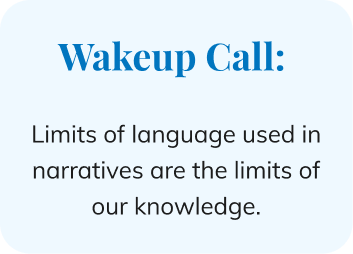Did you know that companies can perform no better than the limitations placed on them through their shared narrative?
Companies can perform no better than the limitations placed on them through their shared narrative.
High-performance, innovative, scaling companies cultivate a narrative that unlocks the collective imagination and nourishes individual motivation to grow.
We humans make sense of our world, declare meaning in our existence, and find direction in our lives through our narratives.
Most remarkably, through our inner narrative, we shape and change our environment according to our desires and visions about how it should be. Our otherwise random and chaotic world is given structure and meaning through the narratives we tell ourselves and others. Narratives create the structure our social environment (culture) needs to survive and thrive.
With repetition, a narrative becomes a natural part of the culture – expressed through lexicon, rituals, stories, and belief systems.

The smallest components of narratives are called memes. These are the mental equivalents of the genes of the biological world. But they are entities that only exist in our minds. Just like a gene, a meme is a self-replicating unit of transmission, but instead of replicating through the gene pool, memes propagate in our minds through our narratives. They are units of cultural information, the knowledge and skills organization members non-genetically pass from individual to individual across group members and generations. Memes include lexicon, signs, songs, ideas, work processes, and other anthropological mechanisms.
Memes can be very contagious – think about that rumor you cannot get out of your head. When that happens, the meme can be said to have injected its DNA into your brain and hence managed to use you as a vessel for its reproductive ends – you might even infect someone else by “spreading” the rumor.
Only the memes that spread to large numbers of people will survive. To be spread, memes need some competitive edge in relation to the environment and other memes. This competitive edge can be a behavior that proves exceptionally useful for survival, or it can be a particular technology, a thought, or an attitude that gives its host organization an advantage relative to other organizations. If the meme is not competitive, it either dies when superior memes are adopted, or it dies with its host organization when that organization’s competitive disadvantages result in its extinction by others with superior memes.
Organizational cultures that do not adopt new superior memes eventually vanish. Individuals and organizations who successfully transmit better-conceived memes can avoid the negative consequences of obsolete memes (and debilitating narratives) and thereby out-wit those who have not.
With culture, we can change our narrative. However, even a high-productive narrative does not mean that inherently destructive memes do not appear. Despite being the result of conscious activity, memes are still not entirely free of ‘faulty mutations.’ People have always come up with ideas and perspectives that did not work out well but were still chosen.
Here’s a sample list of destructive and productive memes in a culture that achieves scale:
| Destructive Memes | Productive Memes |
|---|---|
| “it’s just the way we do it.” | Is there a better way? |
| Don’t question authority. | Trust, but verify. |
| Don’t do anything until you have permission. | Favor action over inaction. |
| Don’t make waves. | State the uncomfortable truth. |
| Mistakes are a basis for punishment. | Mistakes are part of learning. |
| I’ll go after the low-hanging fruit – that’s good enough. | I’ll start with the low hanging fruit – see what I learn, and then take it to the next level. |
| We are too busy doing the real work to take time to think about the future. | We need to balance our time – getting the revenue-generating jobs out while setting ourselves up for success through the future. |
| That’s too fluffy, and its a waste of my time – just tell me what to do. | I have a hard time with Abstract concepts. Help me learn this so I can apply it and improve what and how we do things. |
Here’s a framework for using memes to influence an organization’s narrative (and culture):
The first step is identifying destructive in-use memes.
Having done that, develop productive alternatives. It is essential to understand what value the organization members get from propagating the destructive meme and make sure you can explain the productive meme in those terms.
Revisit the corporate narrative – its Vision, Values, and strategy. Does it catalyze productive memes?
If you want greater detail about how to scale your midlife business, check out The Mid-Life Business Acceleration Story: A New Perspective on Disruptive Transformation and Exponential Growth
